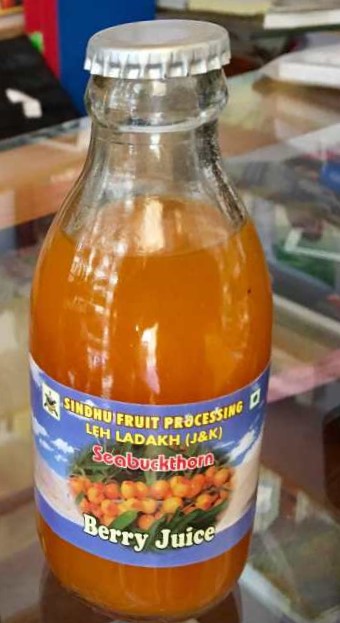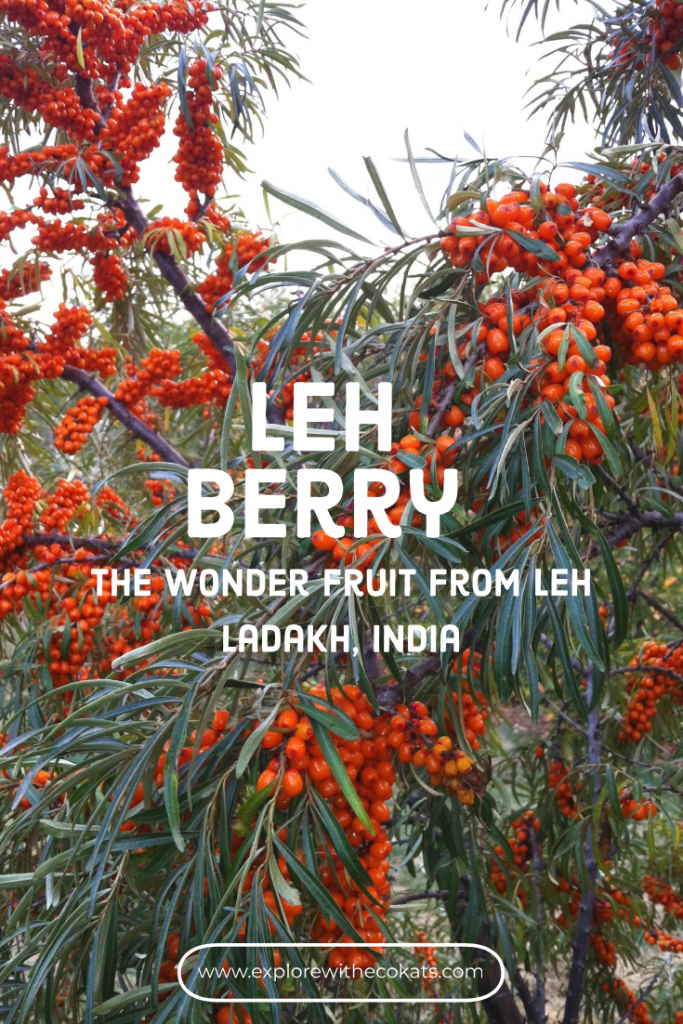Last Updated on March 10, 2024 by
If you are traveling to Leh, you are likely to notice orange coloured mini fruits. Known as Leh Berry or Seabuckthorn, read to know all about it.
While moving from Nubra valley to Leh in our car, the landscape changed a little – from bare, rugged terrain of mountains to something green. A dash of orange colour in those greens caught my eye and I asked the driver what it was. ‘Leh berry’ was his answer.
I was intrigued with the lined up shrubs and how beautiful they looked against those bare mountains and hence went on to ask if they were edible, how they tasted, was anything was made out of them, etc. etc.
The driver stopped the car, disappeared in those green bushes and got some Leh berry for us to taste. It tasted bitter and sour and had only a dash of sweetness which was hardly recognizable. He went on to inform us that the berry supposedly has disease fighting abilities and reduces mountain sickness if consumed my people.
It supposedly improves the memory, strength and fitness of the local community. He promised us to take us to the Leh market where we could buy the packed juice called ‘Leh Berry juice’.
More questions followed with the driver while we drove towards Leh. Lucky for us we did not have to wait to get back to the city to connect to wifi and then google all this information. Our driven enlightened us that he has seen similar berries in other cold and dry regions in India like Garhwal in Uttarakhand, Spiti and Kinnaur in Himachal Pradesh and parts of Sikkim and Arunachal Pradesh.
The fruit is exceptionally resistant to extreme winters as it is a wild shrub and thrives along riverbanks and hill slopes. Some locals have started commercially farming Leh berry or Seabuckthorn and now making a healthy living by making juice and supplying all year round. The juice, which is cited to be extremely healthy, has seen its way in many shopping malls and online stores.

While the name Leh berry made sense, the only thing the driver could not tell us was the origin of the name Seabuckthorn. It has one more name called Hippophae which originates from the Greek words hippo = “horse” and phaos = “to shine” and is due to the ancient Greek use of sea buckthorn leaves as horse fodder to make their coats shine more. The species name rhamnoides means “resembling the Rhamnus”, referring to the buckthorn plant. That did not make sense to me so I am just going to call it Leh Berry – also because it sounds so much cooler!



15 comments
I have never seen or heard of a Leh Berry and would really love to try these in their natural form or as a drink. They do look yummy.
I’ve never met a berry I didn’t like and I don’t think this would be an exception. Did the juice taste similar or was it sweeter? At any rate, it’s beautiful so I can see why it would catch your eye!
It’s amazing what you learn by asking a local. There are so many plants that have medicinal purposes and long histories behind them. Sometimes you just need to slow down and ask the right questions.
Wow I haven’t heard about the Leh Berry or Seabuckthorn. Quite interesting to learn how it got the name and that it helps with Mountain sickness. If I ever visit Leh, will definitely want to try it. Thanks for sharing.
That’s so cool so discover something new like this, I love how it makes somewhere look so much more bright and beautiful but is also a really useful fruit too.
This is so interesting and never heard about leh berry or juice of it.This is just amazing, best to beat mountain sickness than taking diamox☺
Such an interesting fruit. I was fascinated and clicked on the link that took me to its health benefits. I love that it’s an excellent source of antioxidants. I love acidic drinks so I don’t think I’ll have a problem with the flavor 🙂 I’m going to see if I can find a drink that contains this fruit here in Califronia.
I have never heard of the Leh Berry. To know it has health purposes, and to improve memory and strength, I would drink that no matter the taste. It is always neat making these new discoveries while traveling.
I need all the Leh Berry juice I can get then-fights mountain sickness and improves memory, strength, and *ahem* fitness? Yes, please! That would make it worth the bitter and sour taste!
It is an interesting fruit grown in the high Himalaya. It’s claims to ward off mountain sickness though are highly suspect. The truth in hard science is that Sea Buckthorn contains Vitamin C content that is nearly 15 times greater than that of oranges (you need to eat the same amount of berry to make up the volume from one orange), and also contains high levels of amino acids, carotenoids, minerals, vitamin E, and even Omega-3 fatty acids. It is as super fruit though very astringent to the palate I find.
I’ve never seen or heard of these berries before and they’re definitely beautiful like you said! And I agree too, Leh berry sounds much cooler. Plus, it’s easier to remember hahaa.
I will definitely try thiis berry juice when I visit Ladakh next year. Had heard of these berries from a friend who visited Leh Ladakh recently. But after reading your blog have a perfect idea of what to expect. Thanks.
I had never heard of the Leh berry. And reading through your post has been quite enlightening. Thanks for sharing wonderful bits of information.
[…] the Bactrian camel safari. The second is Leh Berry or seabuckthorn. This fruit grows wild and has medicinal values such as reducing altitude sickness and improves […]
oIRXIwzofH4BCOJv9tyU7F8hQVN9mJooPY8vwJweyQyJrqhWKvtHmMHopbb6hp6tFvfY0QT1EsdAWJ9gft7aMUcvMVKjsDJmxCNgmTwfKIjHfyQyGSm0oqcjWFX3JVqkYmLa5w6kIK3FnOLbzg5xGHJBS5tnK0hYT65Q2FHzZY6Ef